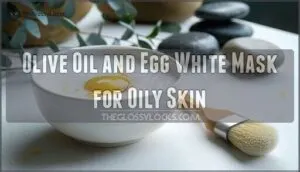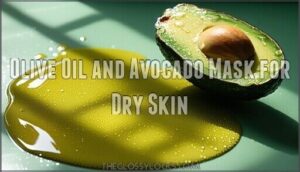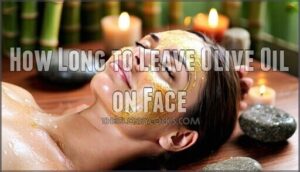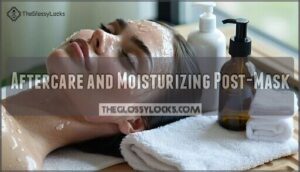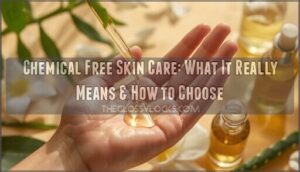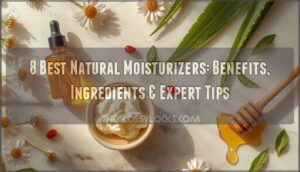This site is supported by our readers. We may earn a commission, at no cost to you, if you purchase through links.
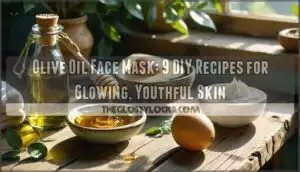
This kitchen staple works like a gentle moisturizer, packed with antioxidants that help fight signs of aging while nourishing your skin.
Simply apply the oil to clean skin, let it sit for 15-20 minutes, then rinse with warm water.
For different skin types, you’ll want to mix in specific ingredients—honey works wonders for dry skin, while egg whites help control oiliness.
The key is choosing the right olive oil and knowing which combinations work best for your unique skin concerns.
Table Of Contents
- Key Takeaways
- Benefits of Olive Oil for Skin Care
- Is Olive Oil Safe for Facial Use?
- How to Choose The Right Olive Oil
- Preparing Your Skin for an Olive Oil Mask
- Basic Olive Oil Face Mask Recipe
- Olive Oil and Honey Mask
- Olive Oil and Egg White Mask for Oily Skin
- Olive Oil and Avocado Mask for Dry Skin
- How Long to Leave Olive Oil on Face
- Aftercare and Moisturizing Post-Mask
- Frequently Asked Questions (FAQs)
- Is olive oil good for a face mask?
- Is it good to apply olive oil on the face?
- How do you make an olive oil face mask?
- Does olive oil really tighten skin?
- Is olive oil good for face masks?
- Is it okay to put olive oil on your face?
- How long to leave olive oil on face?
- How to make an olive oil face mask?
- How often should I use an olive oil mask?
- Are there any potential side effects or allergic reactions?
- Conclusion
Key Takeaways
- Choose extra virgin olive oil – You’ll get maximum antioxidants and skin benefits from cold-pressed, extra virgin varieties that smell fresh and taste slightly peppery, unlike processed oils that lose their potency.
- Customize your mask for your skin type – Mix olive oil with honey for dry skin hydration, egg whites to control oily skin and tighten pores, or avocado for intense moisture if you’re dealing with severely dry patches.
- Always patch test first – Apply a small amount behind your ear and wait 24 hours before using any olive oil mask, especially if you have acne-prone or sensitive skin that might react negatively.
- Time it right for best results – Leave your olive oil mask on for 15-20 minutes for regular treatments, use it once weekly to avoid overwhelming your skin, and follow up with gentle cleansing using lukewarm water.
Benefits of Olive Oil for Skin Care
You’ve probably seen olive oil transform a simple salad, but this kitchen staple can work similar magic on your skin through its powerful antioxidants, natural moisturizing properties, and proven anti-aging compounds.
When you apply olive oil to your face, you’re giving your skin a dose of vitamin E, polyphenols, and healthy fatty acids that help fight free radicals, boost hydration, and maintain elasticity for a more youthful appearance with anti-aging compounds.
Antioxidant Properties
The antioxidants in olive oil act like your skin’s personal bodyguards.
Vitamin E and polyphenols excel at free radical scavenging, preventing oxidative stress that causes wrinkles and dullness.
These powerful compounds deliver anti-inflammatory action while polyphenol benefits include boosting collagen production.
Your skin gets protection from environmental damage, keeping it youthful and resilient against aging.
To further enhance these effects, consider incorporating products with key ingredients like retinol, known for their skin-renewing properties.
Moisturizing Effects
Your skin craves the deep hydration levels that olive oil naturally provides.
Your skin thirsts for the luxurious moisture that only pure olive oil can deliver.
This powerhouse ingredient strengthens your skin barrier while delivering dryness relief through essential lipid replenishment.
An olive oil mask works as the perfect moisturizing mask for skin hydration, transforming rough patches into smooth comfort.
Experience noticeable softness improvement as this dry skin remedy showcases incredible olive oil benefits for lasting moisture.
It also offers antibacterial acne benefits by combating acne-causing bacteria.
Anti-Aging Qualities
Countless beauty treatments promise youth, but olive oil delivers real antiaging mask benefits through powerful antioxidant protection. Its vitamin E and polyphenols combat free radical damage while boosting collagen production for improved skin elasticity.
Regular use supports fine line reduction and wrinkle reduction, making olive oil benefits a natural fountain of youth. Phytochemicals and polyphenols in skincare can further enhance these effects.
- Fights environmental damage – Antioxidants shield your skin from pollution and UV stress
- Plumps aging skin – Enhanced collagen keeps your complexion firm and youthful
- Smooths existing lines – Natural compounds help soften wrinkles you already have
Is Olive Oil Safe for Facial Use?
While olive oil brings impressive benefits to your skincare routine, it’s not a one-size-fits-all solution.
Your skin’s unique needs matter more than any trending face mask recipe.
Those with oily or acne-prone skin should proceed carefully, as olive oil’s comedogenic rating means it can potentially clog pores and trigger breakouts.
One benefit is that it has antibacterial properties that can help fight acne.
Before slathering on that golden goodness, consider these safety steps:
- Patch test first – Apply a small amount behind your ear and wait 24 hours for any allergic reactions
- Check oil purity – Low-quality oils may contain irritants that increase skin sensitivity
- Start slowly – Begin with once-weekly usage frequency to gauge your skin’s response
Remember, even natural ingredients can cause allergies.
Listen to your skin’s signals.
How to Choose The Right Olive Oil
You wouldn’t use week-old salad oil for cooking, so don’t settle for low-quality olive oil on your face either.
Choose extra virgin, cold-pressed olive oil with a fresh, slightly bitter taste and fruity aroma, as these qualities indicate the oil retains maximum nutrients and antioxidants for your skin’s benefit.
Extra Virgin Vs. Virgin
Quality matters when selecting oil for your olive oil face mask. Extra virgin olive oil wins hands down with its superior nutrient content and lower acidity levels.
Its minimal processing methods preserve beneficial compounds, while flavor profiles indicate freshness. You can find various product options online.
Virgin oil works too, but extra virgin’s skin suitability makes it the gold standard for skincare. Your face deserves the best grade available.
Cold-Pressed Oil Benefits
Cold-pressed olive oil offers superior quality through gentle nutrient retention.
This minimal processing impact preserves essential antioxidants that deliver enhanced benefits for your face mask.
You’ll get better skin absorption compared to heat-treated oils that lose their potency.
Coldpressed varieties maintain their natural skin benefits, making them the smarter choice for DIY skincare treatments that actually work.
Flavor and Aroma
Beyond cold-pressing techniques, your nose and taste buds become your best guides when selecting premium olive oil for DIY beauty treatments.
High-quality extra virgin olive oil should smell vibrant and taste bold, signaling it’s packed with skin-loving nutrients.
Here’s what to look for when evaluating olive oil:
- Fresh, grassy aromas with hints of green tomato or apple
- Peppery taste that creates a warm sensation in your throat
- Fruity notes reflecting the specific olive variety used
- Balanced aroma intensity without musty or stale odors
- Clean finish when you swallow a small amount
Trust your senses—they’ll steer you toward oils that’ll make your homemade face mask recipe truly shine.
Preparing Your Skin for an Olive Oil Mask
Getting the most from your olive oil face mask starts with proper preparation. Think of it like priming a canvas before painting – you want a clean, smooth surface for the best results.
Begin with thorough skin cleansing to remove makeup, sunscreen, and daily grime. Follow up with gentle exfoliation using a soft washcloth or mild scrub to slough off dead skin cells.
This exfoliation importance can’t be overstated – it allows your homemade face mask to penetrate deeper and work more effectively.
Consider steaming your face for 2-3 minutes with a warm, damp towel. These steam benefits open your pores and boost absorption.
However, allergy concerns matter too. Always do patch testing first – apply a small amount of your face mask recipe to your inner wrist and wait 24 hours to check for reactions.
Skip heavy moisturizers beforehand, as they can create a barrier that prevents your mask from doing its magic.
Basic Olive Oil Face Mask Recipe
Creating this simple olive oil face mask requires just two pantry staples.
Mix 1 tablespoon extra virgin olive oil with 1 teaspoon raw honey until smooth.
This basic face mask recipe delivers powerful hydration while honey acts as nature’s moisture magnet.
Apply evenly, avoiding the eye area, and relax for 15 minutes.
Application Tips: Use gentle circular motions when spreading.
For Mask Frequency, try weekly treatments.
Rinse with lukewarm water, then pat dry.
Expected Results include softer, more radiant skin after your first use.
Olive Oil and Honey Mask
You’ll find that combining olive oil with honey creates one of the most effective natural face masks for hydration and gentle exfoliation.
This powerhouse duo works together to moisturize your skin while honey’s natural enzymes help remove dead skin cells, leaving you with a softer, more radiant complexion.
Ingredients
You’ll need just two powerhouse ingredients for this nourishing olive oil face mask: extra virgin olive oil and raw honey.
These natural beauties work together like old friends, with olive oil delivering antioxidants to fight aging while honey soothes and moisturizes your skin.
Choose cold-pressed extra virgin olive oil for maximum nutrients, and always grab organic options when possible.
Before mixing any mask combinations, patch test both ingredients separately to check for allergy concerns.
Fresh ingredient ratios matter—stale honey won’t give you the same glowing results.
Many consumers purchase different types of honey for various uses.
Method
Creating your olive oil face mask becomes effortless once you’ve gathered your ingredients.
Here’s your step-by-step guide:
- Combine olive oil and honey in a small bowl, stirring until smooth
- Add orange zest and vitamin E oil, mixing thoroughly
- Apply the mixture across your face, avoiding the delicate eye area
- Wait 15-20 minutes, then rinse with lukewarm water
These application techniques guarantee your homemade DIY recipe delivers maximum benefits.
Benefits
This olive oil face mask delivers impressive skin benefits that’ll transform your complexion.
The combination works like a power duo for your face.
| Benefit | How It Helps |
|---|---|
| Skin Hydration | Deep moisture penetration |
| Anti-Inflammatory | Calms irritated skin |
| Makeup Removal | Gentle yet effective |
| Scar Reduction | Promotes healing |
| Skin Glow | Natural radiance boost |
Apply this facial mask weekly for ideal skin moisturizing results to achieve a natural radiance boost.
Olive Oil and Egg White Mask for Oily Skin
For those wrestling with oily skin, this olive oil and egg white mask works like a charm to balance your complexion. The protein-rich egg white acts as nature’s astringent, tightening pores while olive oil provides gentle hydration without clogging.
Here’s what makes this homemade beauty solution so effective:
- Egg White Benefits include natural pore tightening and oil control
- Regulates sebum production at the source
- Reduces fine lines through collagen-boosting proteins
- Antibacterial properties help prevent breakouts
- Creates a firmer, more elastic skin texture
Simply whisk one egg white with a tablespoon of extra virgin olive oil. Apply evenly, avoiding eyes, and relax for 15 minutes before rinsing with cool water for Expected Results.
Olive Oil and Avocado Mask for Dry Skin
Dry skin doesn’t stand a chance against this powerhouse olive oil face mask combo. Avocado brings omega fatty acids while olive oil delivers deep skin hydration – together they’re like a spa treatment in your kitchen.
This olive oil and avocado duo transforms parched skin into a glowing, hydrated masterpiece that rivals any luxury spa treatment.
| Component | Benefit | Application |
|---|---|---|
| Mashed avocado (½) | Rich moisturizing oils | Base ingredient |
| Olive oil (1 tbsp) | Antioxidant protection | Mix thoroughly |
| Optional egg yolk | Extra hydration boost | Add for overnight mask |
Mash half an avocado with olive oil until smooth. This homemade recipe works wonders for parched complexions. Avocado benefits include natural oils that penetrate deeply, while olive oil acts as the perfect moisturizer.
For mask frequency, use weekly. Recipe variations include adding honey for extra nourishment.
olive oil avocado face mask benefits dry skin 2025 skincare research
How Long to Leave Olive Oil on Face
Timing your olive oil face mask application can make or break your skincare routine. The optimal duration depends on your skin’s unique needs and sensitivity level.
*15-30 minutes for daytime masks
- 1-2 hours for more intense treatments
- Overnight application for maximum absorption
Your skin sensitivity plays a vital role in determining how long you should leave the DIY olive oil treatment on. First-timers should start with shorter sessions—think of it like dipping your toes in the water before diving in. Mask frequency matters too; overdoing it can clog pores faster than you can say "moisturizer."
- Picture waking up with baby-soft skin that glows like you’ve been kissed by Mediterranean sunshine
- Imagine never again worrying about dry patches ruining your makeup game
When removing your olive oil face mask, use lukewarm rinse temperature water. Your skin will thank you for this gentle approach to natural skincare.
Aftercare and Moisturizing Post-Mask
After removing your olive oil mask, three essential steps will maximize your results.
Gentle Cleansers remove residue without stripping natural oils.
Follow with Hydration Serums and Toner Use to balance pH levels.
| Step | Product Type | Benefit |
|---|---|---|
| 1 | Gentle Cleansers | Removes mask residue |
| 2 | Hydration Serums | Locks in nutrients |
| 3 | Toner Use | Balances skin pH |
| 4 | Sun Protection | Prevents UV damage |
This moisturizing routine enhances skin hydration tips, improving skin suppleness and skin texture improvement for lasting skin moisture.
Many users prefer mild cleansing options after using a mask.
Frequently Asked Questions (FAQs)
Is olive oil good for a face mask?
Perfectly packed with powerful antioxidants, olive oil makes an excellent face mask ingredient.
You’ll get deep hydration, anti-aging benefits, and gentle cleansing.
Choose extra-virgin varieties for best results on your skin.
Is it good to apply olive oil on the face?
Yes, you can safely apply olive oil to your face.
It’s packed with antioxidants and moisturizing properties that hydrate skin, reduce signs of aging, and won’t clog pores like heavier creams might.
How do you make an olive oil face mask?
Who knew skincare could be as simple as raiding your kitchen pantry?
Mix one tablespoon extra-virgin olive oil with one teaspoon raw honey.
Apply for twenty minutes, then rinse with lukewarm water for glowing skin.
Does olive oil really tighten skin?
Olive oil can improve skin elasticity and firmness through its antioxidants and fatty acids, but it won’t dramatically tighten loose skin.
You’ll notice softer, more supple skin rather than significant lifting effects.
Is olive oil good for face masks?
Like ancient beauty queens discovered centuries ago, you’ll find olive oil makes excellent face masks.
It’s packed with antioxidants, deeply moisturizes, and won’t clog your pores—making it perfect for most skin types.
Is it okay to put olive oil on your face?
You can safely apply olive oil to your face as a natural moisturizer.
Extra virgin olive oil works best, providing deep hydration and antioxidant protection without clogging pores for most skin types.
How long to leave olive oil on face?
Time flies when you’re pampering your skin.
Leave olive oil on your face for 15-20 minutes for masks, or overnight as a moisturizer.
Start with shorter periods to test your skin’s reaction first.
How to make an olive oil face mask?
Mix one tablespoon extra virgin olive oil with one teaspoon honey for basic hydration.
You can add mashed avocado for dry skin or egg white for oily skin.
Apply, relax twenty minutes, then rinse.
How often should I use an olive oil mask?
You should use an olive oil mask once a week for best results. This frequency allows your skin to absorb the benefits without overwhelming it, maintaining healthy hydration and glow.
Are there any potential side effects or allergic reactions?
Potential problems pose possible pitfalls for some people.
You might experience breakouts if you’re acne-prone, allergic reactions with olive sensitivities, or clogged pores on oily skin.
Always patch-test first before full application.
Conclusion
Picture your skin drinking in nature’s liquid gold, transforming from dull to radiant with each olive oil face mask treatment.
You’ve discovered powerful recipes that harness antioxidants and natural moisturizers to combat aging while addressing specific skin concerns.
Whether you’re battling dryness, oiliness, or simply seeking that coveted glow, these DIY masks offer affordable solutions using ingredients from your kitchen.
Remember to patch test first, choose quality extra virgin olive oil, and enjoy your journey to healthier, more youthful-looking skin.




